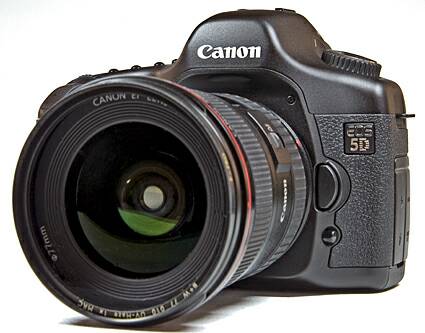Holiday Buyer's Guide 2005
On To Cameras: The Canon 5D
Once you have your sexy notebook, you might want to accompany it with a new digital camera; we have several models to choose from.
The Canon 5D Digital SLR is a member of the company's successful and highly regarded EOS product line. With a 35 mm full-sized 12.8 megapixel CMOS sensor, it's about as close as you can get to full-bore professional photography without breaking the $5,000 price barrier. Canon uses its pioneering experience in building affordable, capable digital cameras with full-sized sensors, to deliver a very nice product in its EOS 5D camera.
The real importance of a full-sized sensor has to do with the ratio of sensor size to pixel area. Simply put, the bigger the sensor, the more room for pixels to capture digital image data. A bigger area also means that camera designers have more room to work with and can use larger, less tightly-packed pixels as well. More pixels translate into higher resolution for sharper, more detailed images, while larger pixels mean digital images with less noise.
For mere mortals, this all means pictures you can enlarge to bigger sizes, and more flexibility when editing or cropping the images for finishing or printing. It also means that images are large, and explains why we recommend a 2 GB or 4 GB flash card for use with this camera (for more information on this and other technical digital camera subjects, see our complete review of this camera).
Canon EOS 5D Full Frame Digital SLR
Another issue is that a camera with a full frame rectangular sensor matches the frame size for 35 mm film. This means that photo lenses designed for 35 mm film also work perfectly and precisely with this kind of digital sensor. A smaller sensor with the same lens captures less than the full image, even though that image is typically what appears in the viewfinder. That explains why focal lengths for lenses on cameras that don't offer full-sized sensors often required a bit of fiddling and calculation to determine exactly what the camera does capture and thus, how to frame shots correctly. The EOS 5D does away with all that, and lets you shoot just as you would with any 35 mm film camera; it uses standard 35mm lenses too.
Another nice aspect of the EOS 5D is its controls. A single button lets you call up menus, view exposure and other image meta-data, and see the images themselves. Deleting images simply requires pressing the trash can while viewing an image, or using the wheel to delete one or more images on the flash memory card. The LCD on top of the camera shows settings for ISO (sensitivity), exposure meter parameters and while balance. These controls are handled by pressing a button and releasing it, then rotating one of the camera's two selector wheels (one on the back, the other at the top front). Though operation may sound complex, it's actually easy to learn, use, and remember.
Get Tom's Hardware's best news and in-depth reviews, straight to your inbox.
The proof of any camera's abilities come from its images, of course. The EOS 5D shoots great pictures, with exposure and color are right where they should be. Many expert photographers report less need for editing in programs like PhotoShop, simply because the images the camera produces are so great. PhotoShop's Camera Raw Filter 3.2 works with raw images from the EOS 5D (which is good, because there's no official raw filter available for this camera just yet, and the Canon software appears to have problems).
Great though this camera is, it also comes at a hefty price: the MSRP is $3,300. Santa may have to grit his teeth to cough up enough green to cover this purchase, but the results should bring a smile to anybody's face.
Current page: On To Cameras: The Canon 5D
Prev Page A Qosimo By Any Other Name Next Page HP Photosmart R817 Digital Camera And Waterproof CaseEd Tittel is a long-time IT writer, researcher and consultant, and occasional contributor to Tom’s Hardware. A Windows Insider MVP since 2018, he likes to cover OS-related driver, troubleshooting, and security topics.

